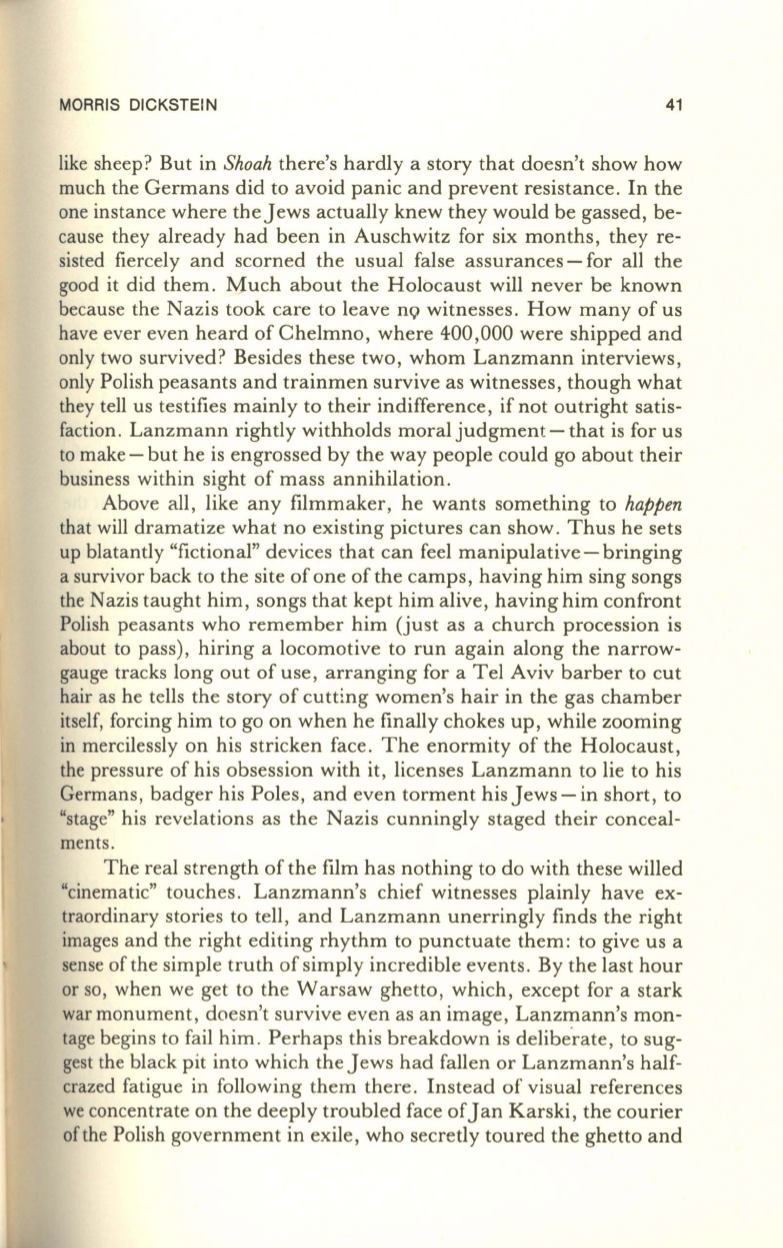
MORRIS DICKSTEIN
41
like sheep? But in
Shoah
there's hardly a story that doesn't show how
much the Germans did to avoid panic and prevent resistance. In the
one instance where the Jews actually knew they would be gassed, be–
cause they already had been in Auschwitz for six months, they re–
sisted fiercely and scorned the usual false assurances - for all the
good it did them. Much about the Holocaust will never be known
because the Nazis took care to leave nQ witnesses. How many of us
have ever even heard of Chelmno, where 400,000 were shipped and
only two survived? Besides these two, whom Lanzmann interviews,
only Polish peasants and trainmen survive as witnesses, though what
they tell us testifies mainly to their indifference, if not outright satis–
faction. Lanzmann rightly withholds moral judgment - that is for us
to make - but he is engrossed by the way people could go about their
business within sight of mass annihilation.
Above all, like any filmmaker, he wants something to
happen
that will dramatize what no existing pictures can show. Thus he sets
up blatantly "fictional" devices that can feel manipulative - bringing
a survivor back to the site of one of the camps, having him sing songs
the Nazis taught him, songs that kept him alive, having him confront
Polish peasants who remember him (just as a church procession is
about to pass), hiring a locomotive to run again along the narrow–
gauge tracks long out of use, arranging for a Tel Aviv barber to cut
hair as he tells the story of cutting women's hair in the gas chamber
itself, forcing him to go on when he finally chokes up, while zooming
in mercilessly on his stricken face. The enormity of the Holocaust,
the pressure of his obsession with it, licenses Lanzmann to lie to his
Germans, badger his Poles, and even torment hisJews-in short, to
"stage" his revelations as the Nazis cunningly staged their conceal–
ments .
The real strength of the film has nothing to do with these willed
"cinematic" touches. Lanzmann's chief witnesses plainly have ex–
traordinary stories to tell, and Lanzmann unerringly finds the right
images and the right editing rhythm to punctuate them: to give us a
sense of the simple truth of simply incredible events. By the last hour
or so, when we get to the Warsaw ghetto, which, except for a stark
war monument, doesn't survive even as an image, Lanzmann's mon–
tage begins to fail him. Perhaps this breakdown is delibe"rate, to sug–
gest the black pit into which the Jews had fallen or Lanzmann's half–
crazed fatigue in following them there" Instead of visual references
we concentrate on the deeply troubled face ofJan Karski, the courier
of the Polish government in exile, who secretly toured the ghetto and


